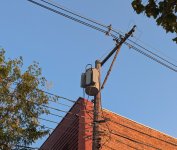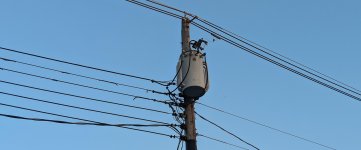mdlueck
Member
- Location
- Michigan, USA
- Occupation
- Sr. IT Architect / Engineer
Greetings,
In Saint Joseph, MI.... the old downtown part of town I observe an unusual transformer configuration. They have AEP as their utility provider.
I see two sets of secondary on the poles. One is clearly USA standard 120/240.
The second set I would assume to be three phase delta 240v. However the transformer powering that bus has only a single connection to the primary, and four secondary connections. The middle two of the secondary are bonded together. Then a total of three wires connect to the bus it powers.
I would suspect three phase open delta. But I am puzzled at how the utility could make three phase anything with only a single primary connection!
We are in Consumers Energy territory of Michigan, and here the utility utilizes two standard 120/240 tubs to deliver three phase open delta. That configuration makes sense to me.
So is the AEP configuration even delivering a type of old three phase.... or a totally different output?
I am thankful,
Michael Lueck
In Saint Joseph, MI.... the old downtown part of town I observe an unusual transformer configuration. They have AEP as their utility provider.
I see two sets of secondary on the poles. One is clearly USA standard 120/240.
The second set I would assume to be three phase delta 240v. However the transformer powering that bus has only a single connection to the primary, and four secondary connections. The middle two of the secondary are bonded together. Then a total of three wires connect to the bus it powers.
I would suspect three phase open delta. But I am puzzled at how the utility could make three phase anything with only a single primary connection!
We are in Consumers Energy territory of Michigan, and here the utility utilizes two standard 120/240 tubs to deliver three phase open delta. That configuration makes sense to me.
So is the AEP configuration even delivering a type of old three phase.... or a totally different output?
I am thankful,
Michael Lueck





